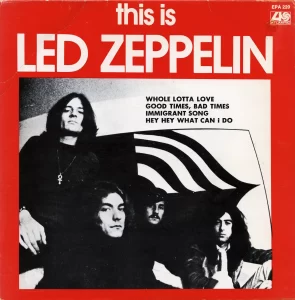


“Dazed and Confused” by Jake Holmes (reworked by Jimmy Page)
Jimmy Page built “Dazed and Confused” based on an acoustic song written by folk singer Jake Holmes. When Page was in The Yardbirds, Holmes would play on the same bill at the Village Theatre in New York City. Page eventually paid Holmes for the right to use the melody of the song. The lyrics of this tune were controversial at the time. For example, the phrase “Lots of people talking, few of them know, the soul of a women was created below” was considered offensive to many people. Zeppelin’s references to subjects, such as strong sexual conquest and the occult, foreshadowed some of the future concepts that would embrace the genre of heavy metal. This song featured a long instrumental improvisation that felt like a drug-induced psychedelic experience, especially when Zeppelin played it live.
“Dazed and Confused” was made up of a long, descending, melodic bassline. Page explained how he developed an idea like “Dazed and Confused“ when he said, “A riff will come out of…this whole thing you do when you practice. I played at home, and before I knew it, things would be coming out, and that’s those little sections or riffs. At that stage, it’s selection and rejection.” “Dazed and Confused” was one of the first songs on which Page utilized a violin bow on his guitar.
